fuel type SKODA SUPERB 2003 1.G / (B5/3U) Owner's Manual
[x] Cancel search | Manufacturer: SKODA, Model Year: 2003, Model line: SUPERB, Model: SKODA SUPERB 2003 1.G / (B5/3U)Pages: 259
Page 8 of 259
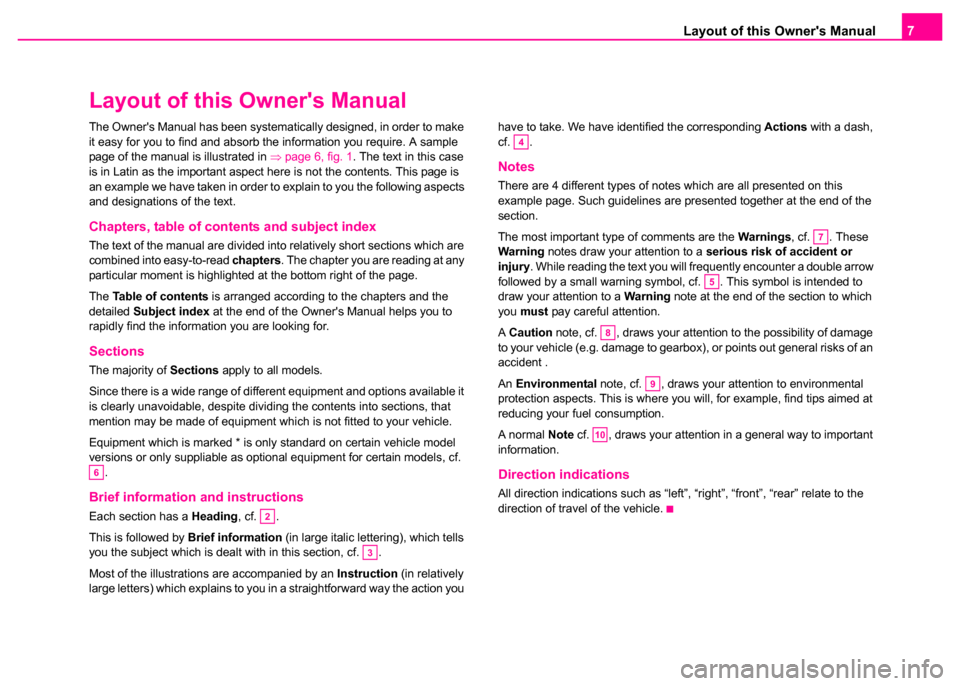
Layout of this Owner's Manual 7
Layout of this Owner's Manual
The Owner's Manual has been systematically designed, in order to make
it easy for you to find and absorb the information you require. A sample
page of the manual is illustrated in ⇒page 6, fig. 1 . The text in this case
is in Latin as the important aspect here is not the contents. This page is
an example we have taken in order to explain to you the following aspects
and designations of the text.
Chapters, table of cont ents and subject index
The text of the manual are divided into relatively short sections which are
combined into easy-to-read chapters. The chapter you are reading at any
particular moment is highlighted at the bottom right of the page.
The Table of contents is arranged according to the chapters and the
detailed Subject index at the end of the Owner's Manual helps you to
rapidly find the information you are looking for.
Sections
The majority of Sections apply to all models.
Since there is a wide range of different equipment and options available it
is clearly unavoidable, despite dividing the contents into sections, that
mention may be made of equipment which is not fitted to your vehicle.
Equipment which is marked * is only standard on certain vehicle model
versions or only suppliable as optional equipment for certain models, cf. .
Brief information and instructions
Each section has a Heading, cf. .
This is followed by Brief information (in large italic lettering), which tells
you the subject which is dealt with in this section, cf. .
Most of the illustrations are accompanied by an Instruction (in relatively
large letters) which explains to you in a straightforward way the action you have to take. We have identified the corresponding
Actions with a dash,
cf. .
Notes
There are 4 different types of notes which are all presented on this
example page. Such guidelines are presented together at the end of the
section.
The most important type of comments are the Warnings, cf. . These
Warning notes draw your attention to a serious risk of accident or
injury . While reading the text you will frequently encounter a double arrow
followed by a small warning symbol, cf. . This symbol is intended to
draw your attention to a Warning note at the end of the section to which
you must pay careful attention.
A Caution note, cf. , draws your attention to the possibility of damage
to your vehicle (e.g. damage to gearbox), or points out general risks of an
accident .
An Environmental note, cf. , draws your attention to environmental
protection aspects. This is where you will, for example, find tips aimed at
reducing your fuel consumption.
A normal Note cf. , draws your attention in a general way to important
information.
Direction indications
All direction indications such as “left”, “right”, “front”, “rear” relate to the
direction of travel of the vehicle.
6
2
3
4
7
5
8
9
10
Page 220 of 259
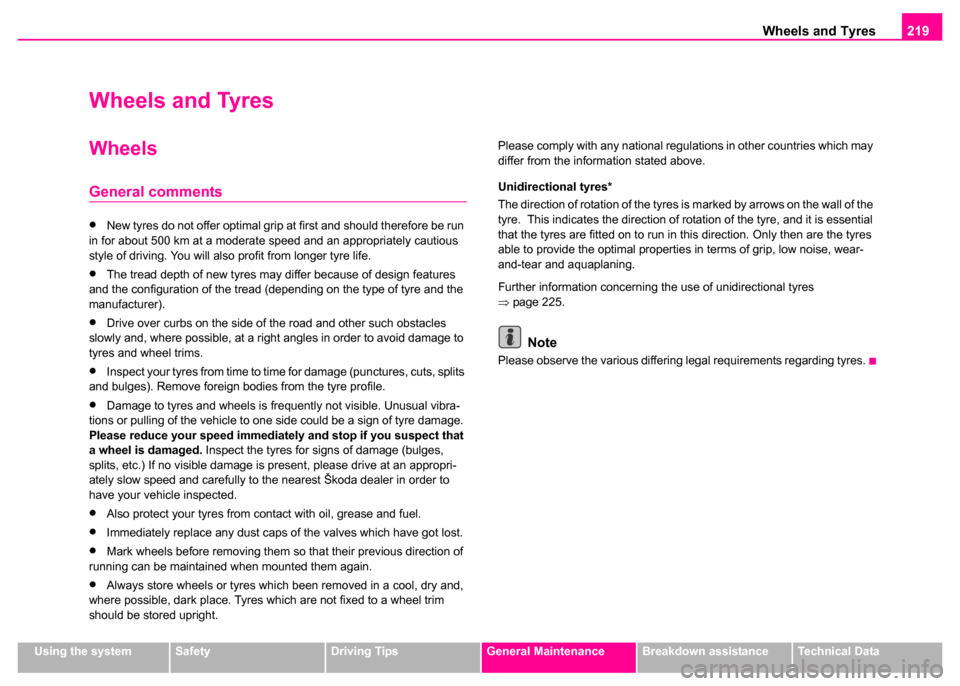
Wheels and Tyres219
Using the systemSafetyDriving TipsGeneral MaintenanceBreakdown assistanceTechnical Data
Wheels and Tyres
Wheels
General comments
•New tyres do not offer optimal grip at first and should therefore be run
in for about 500 km at a moderate speed and an appropriately cautious
style of driving. You will also profit from longer tyre life.
•The tread depth of new tyres may differ because of design features
and the configuration of the tread (depending on the type of tyre and the
manufacturer).
•Drive over curbs on the side of the road and other such obstacles
slowly and, where possible, at a right angles in order to avoid damage to
tyres and wheel trims.
•Inspect your tyres from time to time for damage (punctures, cuts, splits
and bulges). Remove foreign bodies from the tyre profile.
•Damage to tyres and wheels is frequently not visible. Unusual vibra-
tions or pulling of the vehicle to one side could be a sign of tyre damage.
Please reduce your speed immediately and stop if you suspect that
a wheel is damaged. Inspect the tyres for signs of damage (bulges,
splits, etc.) If no visible damage is present, please drive at an appropri-
ately slow speed and carefully to the nearest Škoda dealer in order to
have your vehicle inspected.
•Also protect your tyres from contact with oil, grease and fuel.
•Immediately replace any dust caps of the valves which have got lost.
•Mark wheels before removing them so that their previous direction of
running can be maintained when mounted them again.
•Always store wheels or tyres which been removed in a cool, dry and,
where possible, dark place. Tyres which are not fixed to a wheel trim
should be stored upright. Please comply with any national regulations in other countries which may
differ from the information stated above.
Unidirectional tyres*
The direction of rotation of the tyres is marked by arrows on the wall of the
tyre. This indicates the direction of rotation of the tyre, and it is essential
that the tyres are fitted on to run in this direction. Only then are the tyres
able to provide the optimal properties in terms of grip, low noise, wear-
and-tear and aquaplaning.
Further information concerning the use of unidirectional tyres
⇒
page 225.
Note
Please observe the various differing legal requirements regarding tyres.
Page 225 of 259
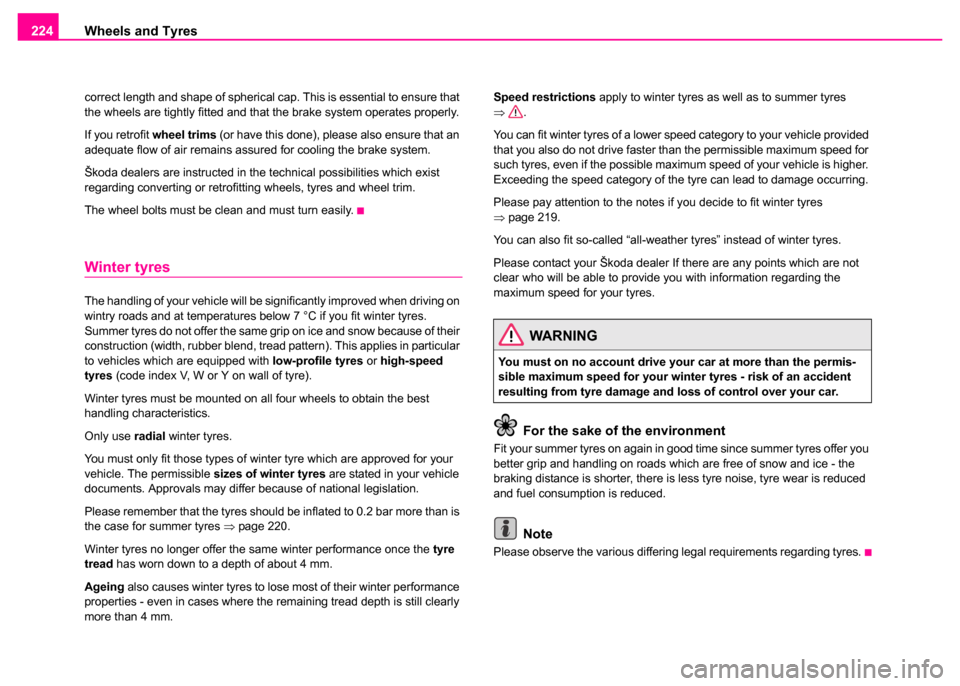
Wheels and Tyres
224
correct length and shape of spherical cap. This is essential to ensure that
the wheels are tightly fitted and that the brake system operates properly.
If you retrofit wheel trims (or have this done), please also ensure that an
adequate flow of air remains assured for cooling the brake system.
Škoda dealers are instructed in the technical possibilities which exist
regarding converting or retrofitting wheels, tyres and wheel trim.
The wheel bolts must be clean and must turn easily.
Winter tyres
The handling of your vehicle will be significantly improved when driving on
wintry roads and at temperatures below 7 °C if you fit winter tyres.
Summer tyres do not offer the same grip on ice and snow because of their
construction (width, rubber blend, tread pattern). This applies in particular
to vehicles which are equipped with low-profile tyres or high-speed
tyres (code index V, W or Y on wall of tyre).
Winter tyres must be mounted on all four wheels to obtain the best
handling characteristics.
Only use radial winter tyres.
You must only fit those types of winter tyre which are approved for your
vehicle. The permissible sizes of winter tyres are stated in your vehicle
documents. Approvals may differ because of national legislation.
Please remember that the tyres should be inflated to 0.2 bar more than is
the case for summer tyres ⇒page 220.
Winter tyres no longer offer the same winter performance once the tyre
tread has worn down to a depth of about 4 mm.
Ageing also causes winter tyres to lose most of their winter performance
properties - even in cases where the remaining tread depth is still clearly
more than 4 mm. Speed restrictions
apply to winter tyres as well as to summer tyres
⇒ .
You can fit winter tyres of a lower speed category to your vehicle provided
that you also do not drive faster than the permissible maximum speed for
such tyres, even if the possible maximum speed of your vehicle is higher.
Exceeding the speed category of the tyre can lead to damage occurring.
Please pay attention to the notes if you decide to fit winter tyres
⇒ page 219.
You can also fit so-called “all-weather tyres” instead of winter tyres.
Please contact your Škoda dealer If there are any points which are not
clear who will be able to provide you with information regarding the
maximum speed fo r your tyres.
For the sake of the environment
Fit your summer tyres on again in good time since summer tyres offer you
better grip and handling on roads which are free of snow and ice - the
braking distance is shorter, there is less tyre noise, tyre wear is reduced
and fuel consumption is reduced.
Note
Please observe the various differing legal requirements regarding tyres.
WARNING
You must on no account drive your car at more than the permis-
sible maximum speed for your winter tyres - risk of an accident
resulting from tyre damage and loss of control over your car.
Page 244 of 259
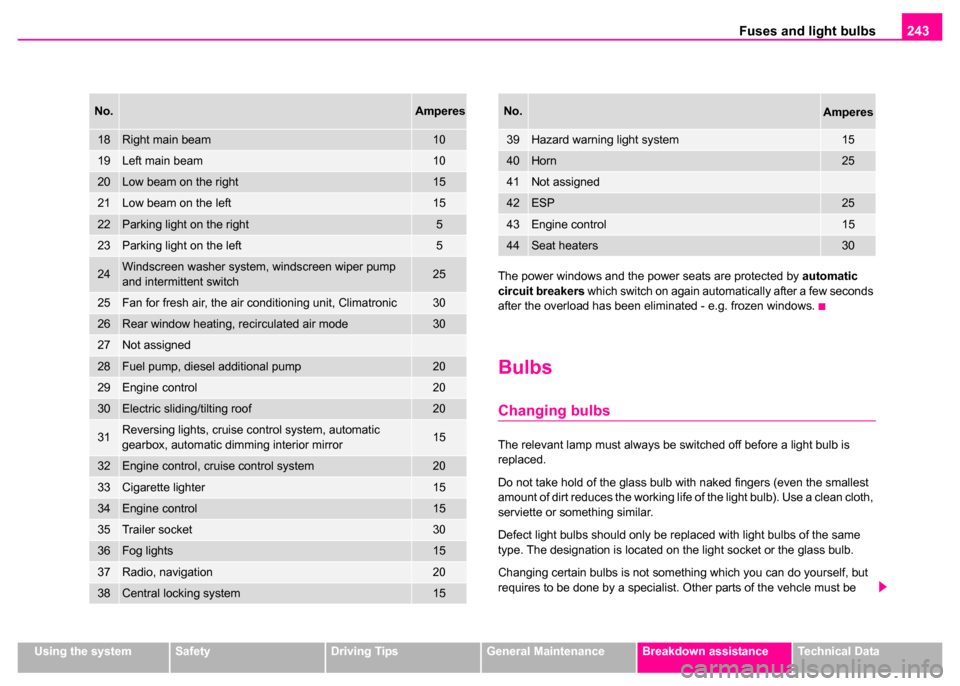
Fuses and light bulbs243
Using the systemSafetyDriving TipsGeneral MaintenanceBreakdown assistanceTechnical Data
The power windows and the power seats are protected by
automatic
circuit breakers which switch on again automatically after a few seconds
after the overload has been eliminated - e.g. frozen windows.
Bulbs
Changing bulbs
The relevant lamp must always be switched off before a light bulb is
replaced.
Do not take hold of the glass bulb with naked fingers (even the smallest
amount of dirt reduces the working life of the light bulb). Use a clean cloth,
serviette or something similar.
Defect light bulbs should only be replaced with light bulbs of the same
type. The designation is located on the light socket or the glass bulb.
Changing certain bulbs is not something which you can do yourself, but
requires to be done by a specialist. Other parts of the vehcle must be
18Right main beam10
19Left main beam10
20Low beam on the right15
21Low beam on the left15
22Parking light on the right5
23Parking light on the left5
24Windscreen washer system, windscreen wiper pump
and intermittent switch25
25Fan for fresh air, the air conditioning unit, Climatronic30
26Rear window heating, recirculated air mode30
27Not assigned
28Fuel pump, diesel additional pump20
29Engine control20
30Electric sliding/tilting roof20
31Reversing lights, cruise control system, automatic
gearbox, automatic dimming interior mirror15
32Engine control, cruise control system20
33Cigarette lighter15
34Engine control15
35Trailer socket30
36Fog lights15
37Radio, navigation 20
38Central locking system15
No.Amperes
39Hazard warning light system15
40Horn25
41Not assigned
42ESP25
43Engine control15
44Seat heaters30
No.Amperes
Page 250 of 259
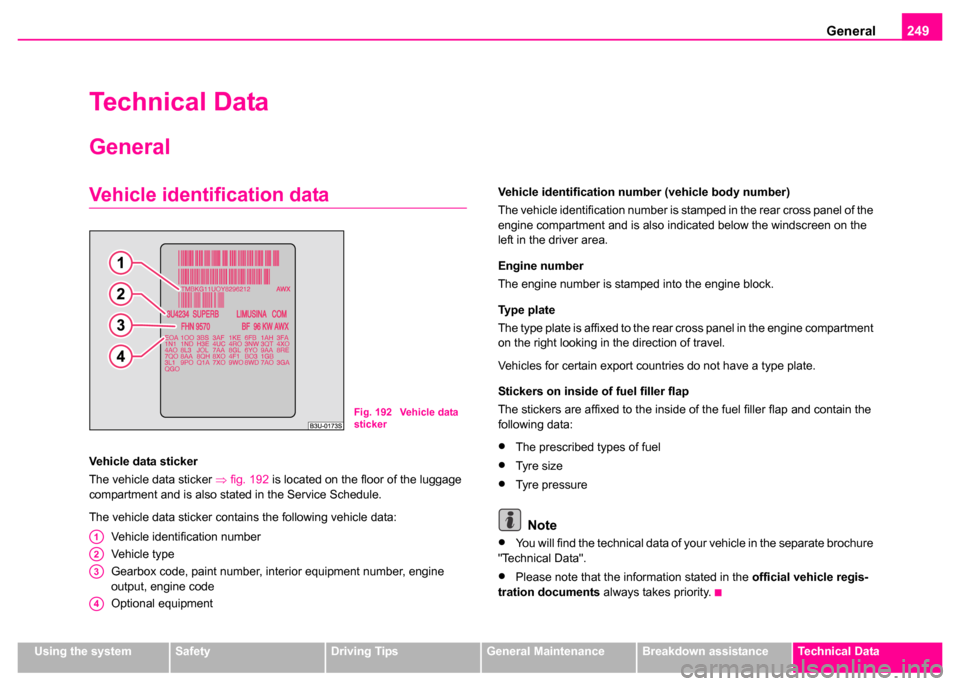
General249
Using the systemSafetyDriving TipsGeneral MaintenanceBreakdown assistanceTechnical Data
Technical Data
General
Vehicle identification data
Vehicle data sticker
The vehicle data sticker ⇒fig. 192 is located on the floor of the luggage
compartment and is also stated in the Service Schedule.
The vehicle data sticker contains the following vehicle data:
Vehicle identification number
Vehicle type
Gearbox code, paint number, interior equipment number, engine
output, engine code
Optional equipment Vehicle identification number (vehicle body number)
The vehicle identification number is stamped in the rear cross panel of the
engine compartment and is also indicated below the windscreen on the
left in the driver area.
Engine number
The engine number is stamped into the engine block.
Ty p e p l a t e
The type plate is affixed to the rear cross panel in the engine compartment
on the right looking in the direction of travel.
Vehicles for certain export countries do not have a type plate.
Stickers on inside of fuel filler flap
The stickers are affixed to the inside of the fuel filler flap and contain the
following data:•The prescribed types of fuel
•Tyre size
•Tyre pressure
Note
•You will find the technical data of your vehicle in the separate brochure
"Technical Data".
•Please note that the information stated in the official vehicle regis-
tration documents always takes priority.
Fig. 192 Vehicle data
sticker
A1
A2
A3
A4
Page 256 of 259
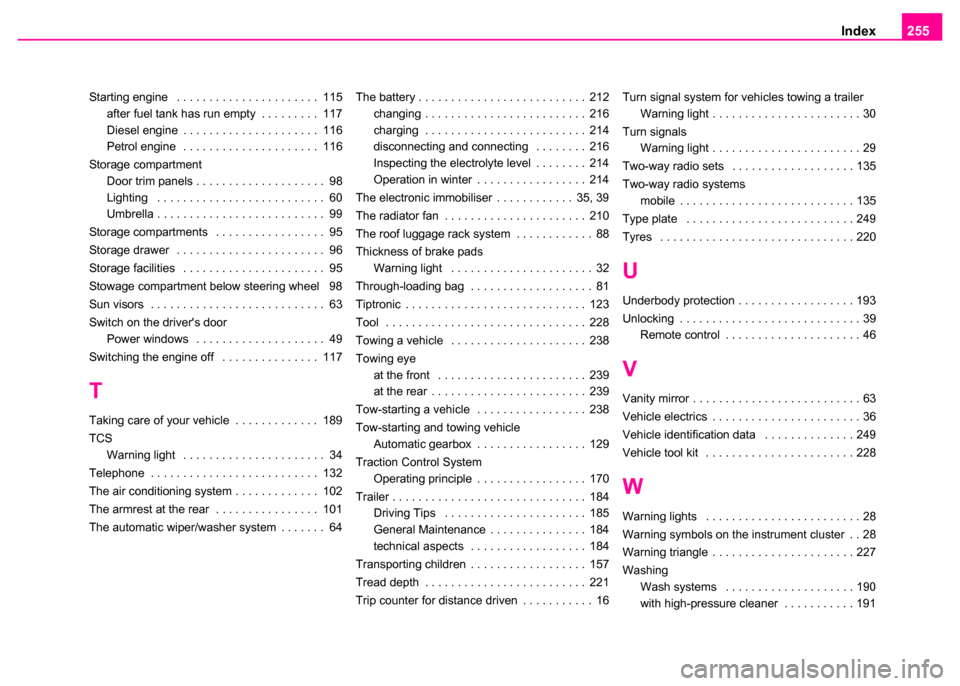
Index255
Starting engine . . . . . . . . . . . . . . . . . . . . . . 115
after fuel tank has run empty . . . . . . . . . 117
Diesel engine . . . . . . . . . . . . . . . . . . . . . 116
Petrol engine . . . . . . . . . . . . . . . . . . . . . 116
Storage compartment Door trim panels . . . . . . . . . . . . . . . . . . . . 98
Lighting . . . . . . . . . . . . . . . . . . . . . . . . . . 60
Umbrella . . . . . . . . . . . . . . . . . . . . . . . . . . 99
Storage compartments . . . . . . . . . . . . . . . . . 95
Storage drawer . . . . . . . . . . . . . . . . . . . . . . . 96
Storage facilities . . . . . . . . . . . . . . . . . . . . . . 95
Stowage compartment below steering wheel 98
Sun visors . . . . . . . . . . . . . . . . . . . . . . . . . . . 63
Switch on the driver's door Power windows . . . . . . . . . . . . . . . . . . . . 49
Switching the engine off . . . . . . . . . . . . . . . 117
T
Taking care of your vehicle . . . . . . . . . . . . . 189
TCS Warning light . . . . . . . . . . . . . . . . . . . . . . 34
Telephone . . . . . . . . . . . . . . . . . . . . . . . . . . 132
The air conditioning system . . . . . . . . . . . . . 102
The armrest at the rear . . . . . . . . . . . . . . . . 101
The automatic wiper/washer system . . . . . . . 64 The battery . . . . . . . . . . . . . . . . . . . . . . . . . . 212
changing . . . . . . . . . . . . . . . . . . . . . . . . . 216
charging . . . . . . . . . . . . . . . . . . . . . . . . . 214
disconnecting and connecting . . . . . . . . 216
Inspecting the electrolyte level . . . . . . . . 214
Operation in winter . . . . . . . . . . . . . . . . . 214
The electronic immobiliser . . . . . . . . . . . . 35, 39
The radiator fan . . . . . . . . . . . . . . . . . . . . . . 210
The roof luggage rack system . . . . . . . . . . . . 88
Thickness of brake pads Warning light . . . . . . . . . . . . . . . . . . . . . . 32
Through-loading bag . . . . . . . . . . . . . . . . . . . 81
Tiptronic . . . . . . . . . . . . . . . . . . . . . . . . . . . . 123
Tool . . . . . . . . . . . . . . . . . . . . . . . . . . . . . . . 228
Towing a vehicle . . . . . . . . . . . . . . . . . . . . . 238
Towing eye at the front . . . . . . . . . . . . . . . . . . . . . . . 239
at the rear . . . . . . . . . . . . . . . . . . . . . . . . 239
Tow-starting a vehicle . . . . . . . . . . . . . . . . . 238
Tow-starting and towing vehicle Automatic gearbox . . . . . . . . . . . . . . . . . 129
Traction Control System Operating principle . . . . . . . . . . . . . . . . . 170
Trailer . . . . . . . . . . . . . . . . . . . . . . . . . . . . . . 184 Driving Tips . . . . . . . . . . . . . . . . . . . . . . 185
General Maintenance . . . . . . . . . . . . . . . 184
technical aspects . . . . . . . . . . . . . . . . . . 184
Transporting children . . . . . . . . . . . . . . . . . . 157
Tread depth . . . . . . . . . . . . . . . . . . . . . . . . . 221
Trip counter for distance driven . . . . . . . . . . . 16 Turn signal system for vehicles towing a trailer
Warning light . . . . . . . . . . . . . . . . . . . . . . . 30
Turn signals Warning light . . . . . . . . . . . . . . . . . . . . . . . 29
Two-way radio sets . . . . . . . . . . . . . . . . . . . 135
Two-way radio systems mobile . . . . . . . . . . . . . . . . . . . . . . . . . . . 135
Type plate . . . . . . . . . . . . . . . . . . . . . . . . . . 249
Tyres . . . . . . . . . . . . . . . . . . . . . . . . . . . . . . 220
U
Underbody protection . . . . . . . . . . . . . . . . . . 193
Unlocking . . . . . . . . . . . . . . . . . . . . . . . . . . . . 39 Remote control . . . . . . . . . . . . . . . . . . . . . 46
V
Vanity mirror . . . . . . . . . . . . . . . . . . . . . . . . . . 63
Vehicle electrics . . . . . . . . . . . . . . . . . . . . . . . 36
Vehicle identification data . . . . . . . . . . . . . . 249
Vehicle tool kit . . . . . . . . . . . . . . . . . . . . . . . 228
W
Warning lights . . . . . . . . . . . . . . . . . . . . . . . . 28
Warning symbols on the instrument cluster . . 28
Warning triangle . . . . . . . . . . . . . . . . . . . . . . 227
WashingWash systems . . . . . . . . . . . . . . . . . . . . 190
with high-pressure cleaner . . . . . . . . . . . 191